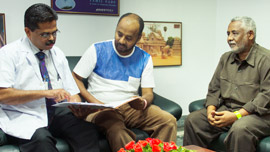Clinical Focus
Most of the urinary problems in children are picked up even before they are born on the ultrasound scan done during pregnancy. Some times these are detected when testing after an episode of urinary infection which manifests in a child as fever, crying and painful straining to pass urine. Whenever these symptoms are there a lab test of urine is essential. A positive urine test for infection needs careful further evaluation.
Older children are sometimes able to tell pain or blood in urine and difficulty to pass urine. After scanning a stone or kidney stretching is detected. They need careful evaluation for detecting the cause of the problem.
We have full facilities to manage the following problems
Kidney Stretching (Hydronephrosis)
When there is blockage in the pipe draining urine from the kidneys, the kidney swells up with urine. When the blockage is high up (PUJ) the kidney alone swells. When kidney stretching is detected during pregnancy it self, it needs careful evaluation after birth on day three of life. If it is mild, these babies need to take a small dose of antibiotic every night to prevent urine infection settling in. When the stretching is severe, it needs a prompt surgical correction to prevent loss of kidney function. A surgery called pyeloplasty is done for blockage at PUJ, where the blocked portion is removed and tubes reconnected.
Posterior Urethral Valves (PUV)
Newborn male children can have a birth defect called PUV. This causes a valve like blockage to the pipe draining the bladder. They can get severe infection as soon as birth. As both kidneys are blocked, kidney function may reduce and they might develop kidney failure. A special X-Ray called MCU and ultrasound scan helps to make the diagnosis. As soon as the baby is born, this can be corrected with the help of an endoscope. Regular follow up is necessary to assess kidney function.
Vesico Ureteric Reflux (VUR- Reflux)
Generally the urine from the kidney is passed downwards only, as a one-way traffic. In some children it might go upstream from the bladder to kidneys. This is called Reflux. This causes urine stagnation and predisposes to urinary infection. The microbes can reach kidneys and cause damage. This heals by a scar, and slowly the kidney loses function. An X-Ray called MCU is required to make the diagnosis. A test called DMSA scan is required to assess the extent of damage. Most of these children grow out of it and they need to take daily antibiotics (once at night) to prevent urine infection. This might be needed for years. Despite taking regular medicines if one develops urine infection, or the kidney damage is progressing, then a surgery is recommended to cure the reflux. This provides 95% success and prevents kidney damage. Of late reflux can be treated without open surgery with the help of endoscope and laparoscope.
Urinary stone
Like adults children can also develop stones in kidneys or urinary tract. They can have blood in urine and urine infection. Older children can tell pain in the low back. Presence of a stone is confirmed with the help of an ultrasound scan and X-Ray. In modern medicine most of the stones are treated without surgery with the help of an endoscope. A technique called ESWL is available where the stones are broken completely from outside using ultrasonic waves. It is essential to do further tests in children as they can have an under lying biochemical or kidney problem causing it. Drinking plenty of water and following the dietary advice is essential to prevent further stone formation.
Phimosis/ Circumcision
In small boys the foreskin over the penis may become narrow making it difficult for them to pass urine. They might strain to pass urine and there might be ballooning of the foreskin. They might also develop urine infection and infection around the tip. If the narrowing is severe, an operation called circumcision is recommended to prevent further problems.
Undescended testis
Baby boys have two testes in the scrotal sac. Initially the testes are inside the belly only. During the development, they slowly come out and reach the scrotum. When this does not happen, undescended testis develops. This can be detected at birth, and these children need careful check up to see whether they descend spontaneously. After one year of age, this is unlikely and a surgery is recommended. If surgery is delayed beyond two years, they are at risk of developing infertility as their semen production is affected by exposure to high body temperature.
Hypospadias
Boys are able to pass urine in a standing position from the tip of the penis. In children with hypospadias, the penis is bent and the hole is on the under surface. Because of this, they cannot pass urine in standing position, the urine sprays and dribbles along their legs. This problem is detected at birth itself and they need careful checkups to make sure that the penis is growing to a good size. They can have corrective surgery between 6 months and 2 years. Failure to do surgical correction at the right age affects their toilet training. This can cause psychological problems when they reach school. A straight penis and an opening at the tip are essential for a successful sexual performance and fertility. When left uncorrected they can have sexual problems and infertility in later life, as all the semen leaks out through the hole underneath.
















